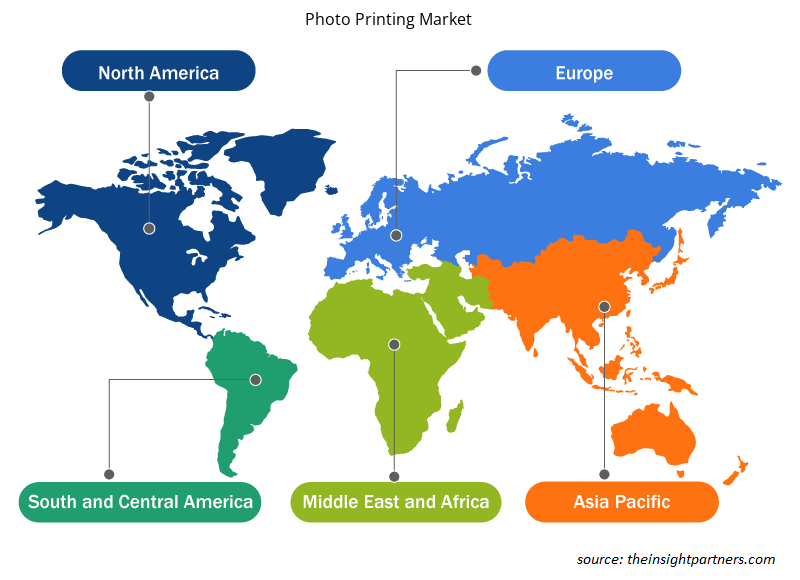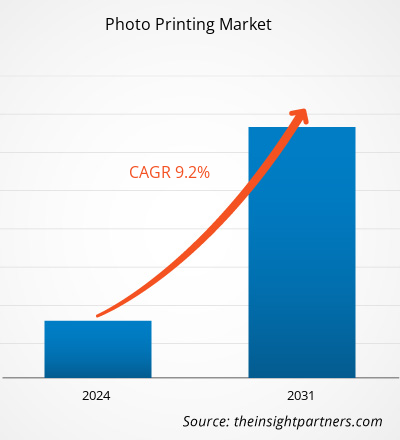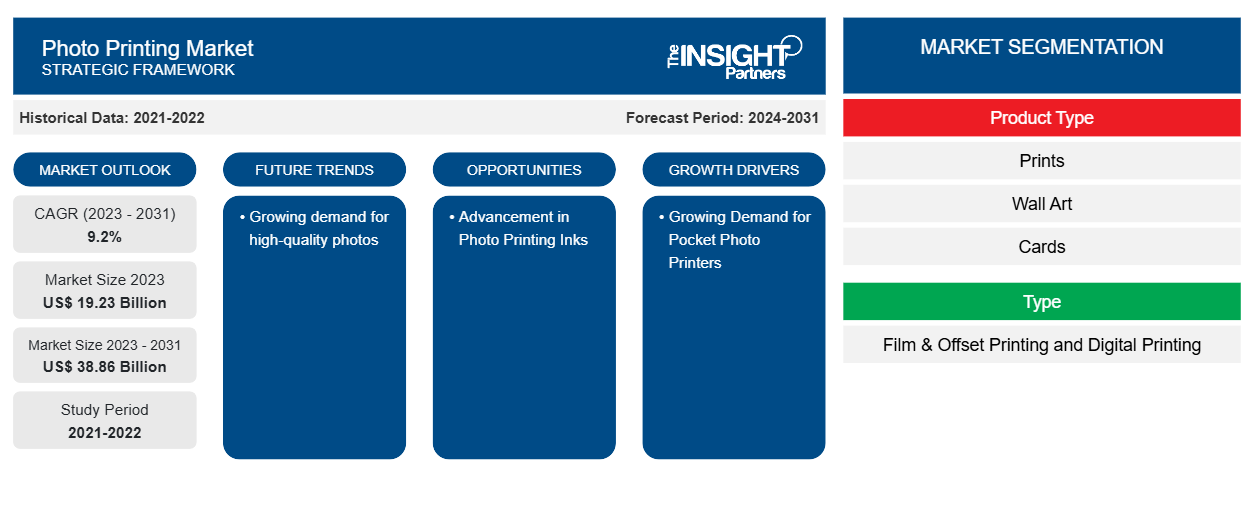Der Markt für Fotodruck soll von 38,86 Milliarden US-Dollar im Jahr 2023 auf 19,23 Milliarden US-Dollar im Jahr 2031 anwachsen. Der Markt wird voraussichtlich zwischen 2023 und 2031 eine durchschnittliche jährliche Wachstumsrate von 9,2 % verzeichnen. Die steigende Nachfrage nach qualitativ hochwertigen Fotos dürfte ein wichtiger Trend auf dem Fotodruckmarkt bleiben.CAGR of 9.2% in 2023–2031. Growing demand for high-quality photos is likely to remain a key photo printing market trend.
Fotodruckanalyse
Der Markt für Fotodruck wächst rasant, da die Nachfrage nach Fotodruckern im Taschenformat steigt und die Verbraucher immer mehr einzigartige und individuelle Fotodrucke wünschen. Der Markt wächst stetig, angetrieben von der steigenden Nachfrage nach umweltfreundlichen Drucktechnologien. Darüber hinaus bieten Fortschritte bei Fotodrucktinten und die steigende Nachfrage nach tintenlosem Drucken lukrative Möglichkeiten für Marktwachstum.
Marktübersicht für Fotodruck
Unter Fotodruck versteht man einen Prozess, bei dem digitale Informationen wie Bilder oder Videos in greifbare Ausdrucke umgewandelt werden, die in Vitrinen, Ausstellungen und Displays angezeigt werden. Bei diesem Prozess wird ein Fotodrucker verwendet, um digitale Bilder oder gescannte Ausdrucke auf Papier oder andere Materialien zu übertragen. Fotodrucker sind hauptsächlich für die Erstellung hochwertiger Ausdrucke mit präzisen Farben und feinen Details konzipiert und werden dafür verwendet. Es gibt zahlreiche Drucktechniken, beispielsweise werden für den Fotodruck Papier , Metall und Leinwand verwendet.
Passen Sie diesen Bericht Ihren Anforderungen an
Sie erhalten kostenlos individuelle Anpassungen an jedem Bericht, einschließlich Teilen dieses Berichts oder einer Analyse auf Länderebene, eines Excel-Datenpakets sowie tolle Angebote und Rabatte für Start-ups und Universitäten.
-
Holen Sie sich die wichtigsten Markttrends aus diesem Bericht.Dieses KOSTENLOSE Beispiel umfasst eine Datenanalyse von Markttrends bis hin zu Schätzungen und Prognosen.
Treiber und Chancen auf dem Fotodruckmarkt
Wachsende Nachfrage nach Fotodruckern im Taschenformat treibt den Markt an
Taschenfotodrucker haben in den letzten Jahren an Popularität gewonnen. Diese Drucker sind tragbar und lassen sich normalerweise über Bluetooth mit Telefonen oder anderen Geräten verbinden, sodass Benutzer von überall aus drucken können. Taschenfotodrucker sind im Alltag unglaublich nützlich, insbesondere für kreative Profis. Darüber hinaus erhöht die wachsende Reise- und Tourismusbranche die Verwendung von Taschenfotodruckern unter Reisenden und belebt den Markt.
Fortschritte bei Fotodrucktinten
Die Drucktechnologie hat bei der Entwicklung von Tinten, die speziell für die Landschaftsfotografie (oder andere Bilder) entwickelt wurden, bemerkenswerte Fortschritte gemacht. Hersteller wie Epson, Canon und HP haben die Entwicklung pigmentbasierter Tinten vorangetrieben, die unglaublich helle und langlebige Drucke erzeugen. Diese Tinten bestehen aus mikroskopisch kleinen Partikeln, die in einer Flüssigkeit schwimmen und so ein breiteres Farbspektrum und eine bessere Lichtbeständigkeit als farbstoffbasierte Tinten bieten. Beispielsweise hat Epson, bekannt für seine PrecisionCore-Technologie, mit seinen UltraChrome Pro-Tinten möglicherweise einen Industriestandard gesetzt. Pigmentbasierte Tinten verbessern die Glanzkonsistenz und verringern die Bronzierung, wodurch ein noch glatteres und raffinierteres Erscheinungsbild entsteht.PrecisionCore technology, may have set an industry standard with its UltraChrome Pro inks. Pigment-based inks improve gloss consistency and decrease bronzing, giving an even smoother and more refined appearance.
Segmentierungsanalyse des Fotodruckmarktberichts
Wichtige Segmente, die zur Ableitung der Marktanalyse für Fotodruck beigetragen haben, sind Produkttyp, Typ und Vertriebskanal.
- Basierend auf dem Produkttyp ist der Fotodruckmarkt in Drucke, Wandkunst, Karten, Fotogeschenke, Fotobücher, Kalender und andere unterteilt. Das Drucksegment hatte im Jahr 2023 einen größeren Marktanteil.
- Auf der Grundlage des Typs wird der Fotodruckmarkt in Film- und Offsetdruck sowie Digitaldruck unterteilt. Das Segment Digitaldruck hatte im Jahr 2023 einen größeren Marktanteil.
- In Bezug auf die Vertriebskanäle ist der Markt in Einzelhandel, Online und Instant-Kiosk segmentiert. Das Online-Segment hielt im Jahr 2023 den größten Marktanteil.
Fotodruck-Marktanteilsanalyse nach geografischer Lage
Der geografische Umfang des Marktberichts zum Fotodruck ist hauptsächlich in fünf Regionen unterteilt: Nordamerika, Asien-Pazifik, Europa, Naher Osten und Afrika sowie Südamerika/Süd- und Mittelamerika.
In Bezug auf den Umsatz hatte Nordamerika den größten Marktanteil im Bereich Fotodruck. Der Markt in dieser Region ist in die USA, Kanada und Mexiko unterteilt. Die zunehmende Nutzung der Digitalfotografie für persönliche Zwecke treibt den Markt an. Die zunehmende Digitalisierung und die zunehmende Nutzung von Smartphones durch Verbraucher zum Aufnehmen und Teilen von Fotos treiben den Markt im Prognosezeitraum an.
Regionale Einblicke in den Fotodruckmarkt
Die regionalen Trends und Faktoren, die den Fotodruckmarkt im Prognosezeitraum beeinflussen, wurden von den Analysten von Insight Partners ausführlich erläutert. In diesem Abschnitt werden auch die Marktsegmente und die Geografie des Fotodruckmarkts in Nordamerika, Europa, im asiatisch-pazifischen Raum, im Nahen Osten und Afrika sowie in Süd- und Mittelamerika erörtert.

- Erhalten Sie regionale Daten zum Fotodruckmarkt
Umfang des Marktberichts zum Fotodruck
| Berichtsattribut | Details |
|---|---|
| Marktgröße im Jahr 2023 | 19,23 Milliarden US-Dollar |
| Marktgröße bis 2031 | 38,86 Milliarden US-Dollar |
| Globale CAGR (2023 - 2031) | 9,2 % |
| Historische Daten | 2021-2022 |
| Prognosezeitraum | 2024–2031 |
| Abgedeckte Segmente |
Nach Produkttyp
|
| Abgedeckte Regionen und Länder |
Nordamerika
|
| Marktführer und wichtige Unternehmensprofile |
|
Marktteilnehmerdichte: Der Einfluss auf die Geschäftsdynamik
Der Markt für Fotodruck wächst rasant, angetrieben durch die steigende Nachfrage der Endnutzer aufgrund von Faktoren wie sich entwickelnden Verbraucherpräferenzen, technologischen Fortschritten und einem größeren Bewusstsein für die Vorteile des Produkts. Mit steigender Nachfrage erweitern Unternehmen ihr Angebot, entwickeln Innovationen, um die Bedürfnisse der Verbraucher zu erfüllen, und nutzen neue Trends, was das Marktwachstum weiter ankurbelt.
Die Marktteilnehmerdichte bezieht sich auf die Verteilung der Firmen oder Unternehmen, die in einem bestimmten Markt oder einer bestimmten Branche tätig sind. Sie gibt an, wie viele Wettbewerber (Marktteilnehmer) in einem bestimmten Marktraum im Verhältnis zu seiner Größe oder seinem gesamten Marktwert präsent sind.
Die wichtigsten auf dem Fotodruckmarkt tätigen Unternehmen sind:
- Fujifilm Corporation
- Adorama Camera, Inc.
- Bay Fotolabor
- Digitalab Ltd.
- Nationen-Fotolabor
- Walgreens Co.
Haftungsausschluss : Die oben aufgeführten Unternehmen sind nicht in einer bestimmten Reihenfolge aufgeführt.

- Überblick über die wichtigsten Akteure auf dem Fotodruckmarkt
Neuigkeiten und aktuelle Entwicklungen auf dem Fotodruckmarkt
Der Fotodruckmarkt wird durch die Erhebung qualitativer und quantitativer Daten nach Primär- und Sekundärforschung bewertet, die wichtige Unternehmensveröffentlichungen, Verbandsdaten und Datenbanken einbezieht. Im Folgenden finden Sie eine Liste der Entwicklungen auf dem Markt für Fotodruck und Strategien:
- Im Juli 2022 kündigte Canon Inc. den SELPHY CP1500 an, einen neuen kabellosen Kompakt-Fotodrucker, der einfach zu bedienen ist und mit personalisierten, hochwertigen Ausdrucken zu begeistern verspricht. Der SELPHY CP1500 verbessert die Lebendigkeit von Porträtdrucken noch weiter. Neben der Verwendung der Farbsublimationstechnologie, die sanftere Farbtöne und sattere Abstufungen ermöglicht, verfügt der SELPHY PRINTER CP 1500 über eine automatische Korrekturfunktion, die Helligkeit, Sättigung, Kontrast und Farbtöne in Bildern anpasst, um ein besseres, klareres Finish zu erzielen. (Quelle: Canon Inc., Pressemitteilung, 2022)
Marktbericht zum Fotodruck – Umfang und Ergebnisse
Der Bericht „Marktgröße und Prognose für Fotodruck (2023–2031)“ bietet eine detaillierte Analyse des Marktes, die die folgenden Bereiche abdeckt:
- Marktgröße und Prognose auf globaler, regionaler und Länderebene für alle wichtigen Marktsegmente, die im Rahmen des Projekts abgedeckt sind
- Marktdynamik wie Treiber, Beschränkungen und wichtige Chancen
- Wichtige Zukunftstrends
- Detaillierte PEST/Porters Five Forces- und SWOT-Analyse
- Globale und regionale Marktanalyse mit wichtigen Markttrends, wichtigen Akteuren, Vorschriften und aktuellen Marktentwicklungen
- Branchenlandschaft und Wettbewerbsanalyse, einschließlich Marktkonzentration, Heatmap-Analyse, prominenten Akteuren und aktuellen Entwicklungen
- Detaillierte Firmenprofile
- Historische Analyse (2 Jahre), Basisjahr, Prognose (7 Jahre) mit CAGR
- PEST- und SWOT-Analyse
- Marktgröße Wert/Volumen – Global, Regional, Land
- Branchen- und Wettbewerbslandschaft
- Excel-Datensatz
Aktuelle Berichte
Verwandte Berichte
Erfahrungsberichte
Grund zum Kauf
- Fundierte Entscheidungsfindung
- Marktdynamik verstehen
- Wettbewerbsanalyse
- Kundeneinblicke
- Marktprognosen
- Risikominimierung
- Strategische Planung
- Investitionsbegründung
- Identifizierung neuer Märkte
- Verbesserung von Marketingstrategien
- Steigerung der Betriebseffizienz
- Anpassung an regulatorische Trends























 Kostenlose Probe anfordern für - Fotodruckmarkt
Kostenlose Probe anfordern für - Fotodruckmarkt